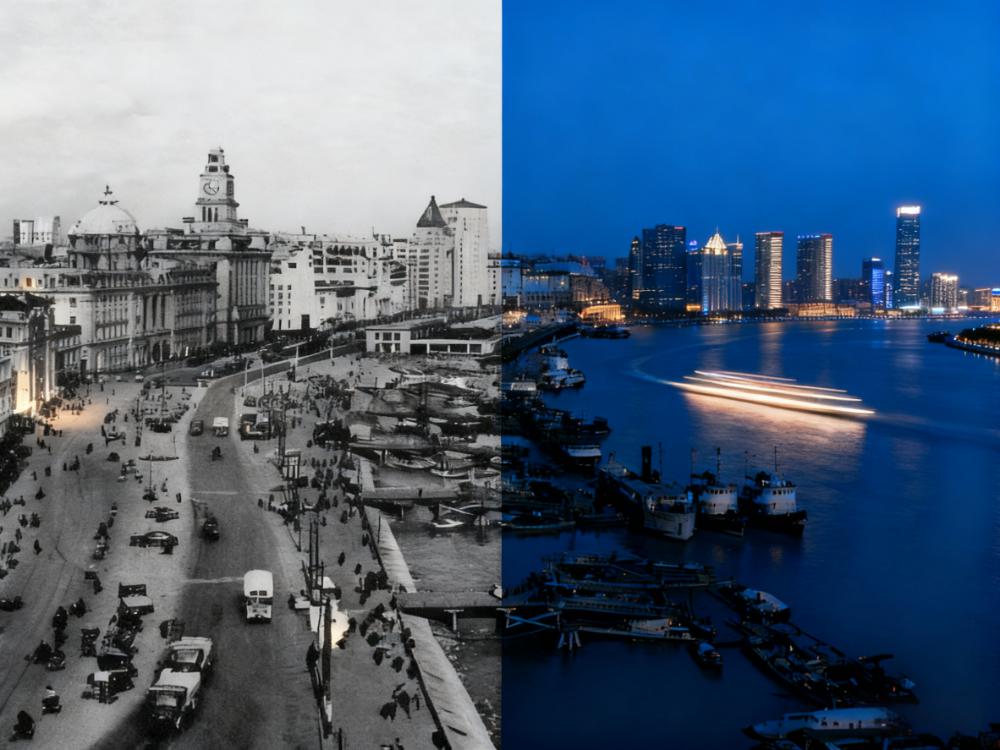Introduction
At the mouth of the Yangtze River, on the banks of the Huangpu, a city tells its legendary story. Once a small fishing village, Shanghai went through the milestones of treaty port opening, foreign concessions, war, liberation, and reform—finally emerging as today’s global metropolis. Let’s journey through time to discover the century-long transformation of the “Pearl of the East.”
From Fishing Village to County Town (Before 1840)
Shanghai’s Origins
Before the Opium War of 1840, Shanghai was just a small county under Songjiang Prefecture with a population of around 200,000. People lived mainly by fishing and farming, with boats along the Huangpu River and reeds swaying on its banks—a tranquil scene of a Jiangnan water town.
Emerging Geographical Advantages
Even then, Shanghai’s location hinted at its future potential:
- Yangtze Estuary: At the mouth of China’s longest river
- Gateway to the East China Sea: A natural deep-water harbor
- Jiangnan Hinterland: Backed by one of China’s wealthiest regions
Early Commercial Activity
Some trade already existed:
- Sandboat Trade: Waterborne transport of goods
- Cotton Trade: Cotton production fueled commerce
- Handicrafts: Textile and shipbuilding industries were emerging
The Treaty Port Years (1843–1860)
The Turning Point: Treaty of Nanjing
In 1842, the Treaty of Nanjing named Shanghai one of five treaty ports. On November 17, 1843, the city officially opened to foreign trade—a date often regarded as Shanghai’s modern “birthday.”
Birth of the Bund
Foreign merchants soon built trading houses and consulates along the Huangpu, forming the early Bund:
- British Consulate (1843): The first foreign building on the Bund
- Trading Houses: Firms like Jardine Matheson and Swire arrived
- Wharves: Modern dock facilities began construction
First Encounters of East and West
Port opening brought large-scale cultural exchange:
- Architecture: Western buildings appeared in Shanghai
- Lifestyle: Western habits influenced local residents
- Business: Modern commercial practices were introduced
The Concession Years (1860–1943)
- Urban Growth: Nanjing Road, Huaihai Road, and modern utilities like electricity and telephones transformed city life.
- Economic Boom: Banks, stock exchanges, and industries made Shanghai the leading port of the Far East.
- Cultural Integration: The birth of Hai Pai culture, Shikumen housing, and modern lifestyles all flourished.
The concessions brought both progress and problems: modernization on one hand, but also inequality and loss of sovereignty.
War and Turmoil (1937–1949)
- Battle of Shanghai (1937): Fierce resistance against Japanese invasion
- “Isolated Island” Period: The concessions stood apart during occupation
- Post-war Years: Brief recovery, followed by civil war and unrest
- Liberation: On May 27, 1949, Shanghai was peacefully liberated
Socialist Transformation (1949–1978)
- Economic Reform: Private industries were nationalized
- Planned Economy: Shanghai became a key industrial base in steel, machinery, textiles, and chemicals
- Cultural Heritage: Despite restrictions, Hai Pai culture and Shikumen traditions continued
Reform and Opening Up (1978–2000)
- Reform Policies: Foreign companies re-entered, modern construction accelerated
- Pudong Development (1990): Lujiazui, Waigaoqiao, and Zhangjiang transformed the skyline
- Urban Changes: Skyscrapers, subways, bridges, and cleaner cityscapes
Entering the New Century (2000–Present)
- 2010 World Expo: Marked Shanghai’s rising global image
- 2013 Pilot Free Trade Zone: Pioneer in trade and financial liberalization
- Science & Innovation: Zhangjiang Science City and global talent initiatives
Today’s Shanghai
- Economic Powerhouse: GDP over 4 trillion yuan, world’s busiest container port
- Cultural Vitality: Creative industries, art, and a modern lifestyle
- Urban Spirit: International, modern, and inclusive
Places that Carry Memory
- The Bund: Historic architecture and iconic night views
- Shikumen: Narrow lanes reflecting Shanghai’s daily life
- Xintiandi: A symbol of cultural renovation and business innovation
Fun Stories
- The Bund as an “Architectural Exhibition”: Each building tells a story
- “Seventy-Two Tenants” of Shikumen: Crowded but lively alley culture
- Pudong’s Overnight Transformation: From farmland to skyscrapers in decades
Practical Tips
- Historical Routes: Bund, Shikumen lanes, Pudong modern district
- Best Seasons: Spring and autumn for pleasant walks and night views
- Getting Around: Metro is fastest; buses are cheap; taxis convenient but pricier

Leave a Reply